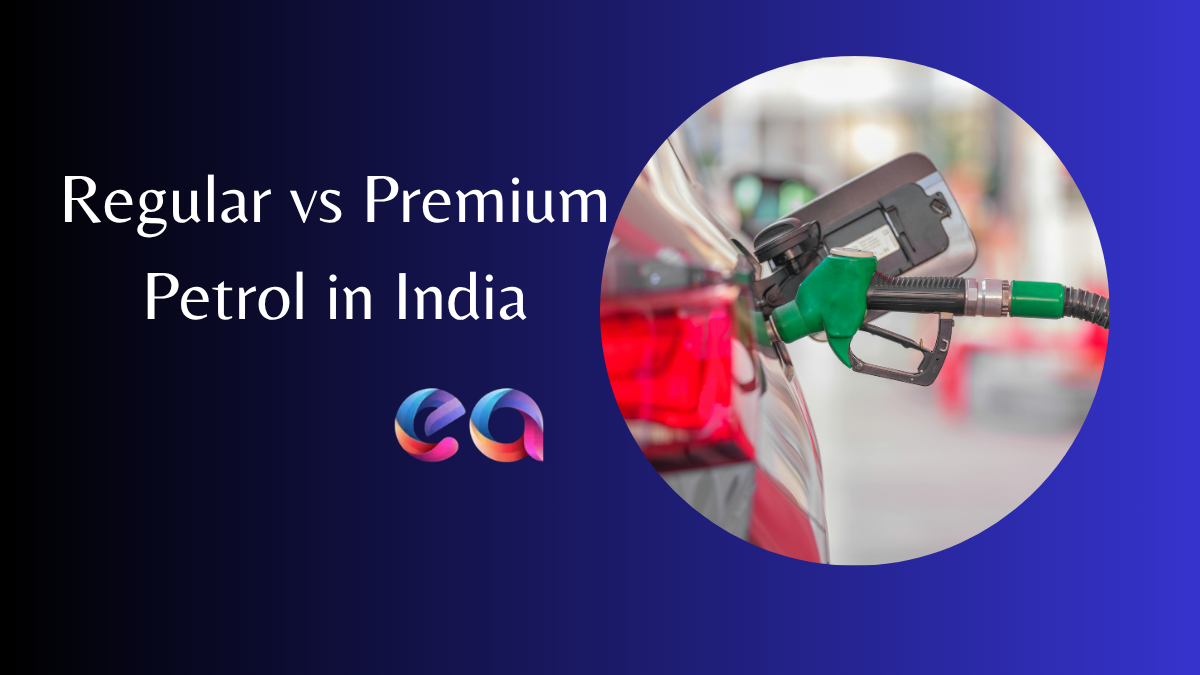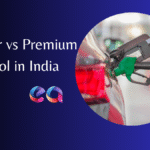
Filling up your tank may feel like a chore—but did you know that choosing between regular and premium petrol can stir a meaningful debate? As fuel prices surge and vehicles evolve, this question is more relevant than ever in India: Does paying extra for premium petrol genuinely deliver value?
In this article, I’ll walk you through how petrol pricing works, what “premium” really means, how different engines respond to it, when it makes sense (and when it doesn’t) for Indian conditions, and how you can make the smartest decision for your car and your wallet.
My aim here is not to hype premium petrol but to help you understand when and where it adds value — and where it doesn’t. Think of this as your definitive guide to fuel choices in India.
Table of Contents
What do we mean by “regular” and “premium” petrol?
Regular / Standard Petrol
In India, the fuel most of us buy is standard petrol (also called “normal unleaded”). It comes with an octane rating that meets minimum requirements set by manufacturers and regulators.
- The octane number here represents the fuel’s resistance to “knocking” (premature ignition) when compressed in the engine. Wikipedia+2Digit Insurance+2
- For many Indian cars (with relatively modest compression ratios), standard petrol is sufficient.
Premium / High-Octane Petrol
Premium petrol is the higher-grade option. It typically offers:
- A higher octane rating than standard.
- Additional additives or detergents designed to keep the engine clean (depending on brand).
- A higher price at the pump.
In India you’ll find names like “XP95”, “Speed 97”, “poWer 95” etc, which indicate premium variants.
Key technical difference: Octane rating
The crux lies in the octane rating:
- A higher octane rating means the fuel can withstand more compression before igniting.
- If your engine compresses the air-fuel mixture strongly (high compression ratio, forced induction turbo, etc), then a high-octane fuel is beneficial to prevent knocking and maintain performance.
- If your engine is not designed for it, the extra octane may go unused — you’ll pay more, but may not get much back in return. Several Indian forums confirm this.
Quick comparison
Here’s a summary:
| Feature | Regular Petrol | Premium Petrol |
|---|---|---|
| Octane rating | Standard/minimum for engine | Higher (91–95 RON or more) |
| Additives & detergents | Basic | Often more advanced |
| Price | Lower | Higher |
| Best suited for | Everyday engines, daily use | High-compression/ performance engines |
| Improvement expected | Minimal if engine not tuned | Noticeable only if engine demands it |
What manufacturers recommend & what it means for you
Why “use the fuel the manufacturer recommends” matters
Every vehicle comes with an owner’s manual which states the minimum fuel octane (or fuel grade) required. If you use a lower grade than required:
- You may face engine knocking, loss of performance, or reduced longevity.
- In worst cases, warranty claims may be affected if damage is linked to fuel misuse.
Conversely, using a higher grade than recommended does not always guarantee meaningful benefit. If the engine is calibrated to use standard petrol, it may not fully exploit a premium grade.
Real-life feedback from Indian car owners
- On the forum Team‑BHP, users noted that in cars tuned for 95 RON, premium fuel made a difference; in cars tuned for 91 RON it didn’t in many cases.
- A Reddit user commented:
“The same is mentioned in bold and capitals in the owner’s manual … That is why it performs better on XP95.” Team-BHP.com
- On another Reddit thread discussing extra premium petrol vs normal:
“Regular/premium/Special Fuel: … the difference is detergent additives in them. But … I don’t think there is a vast difference.”
What this means for you
- Check your manual first: If your car is built to run on standard petrol, you’re likely fine with it.
- If your engine is performance-tuned, forced induction, or explicitly calls for higher octane — then premium fuel may deliver value.
- Don’t assume premium equals huge benefit: If the engine can’t exploit the higher octane, you may pay more without much gain.
Does premium petrol actually deliver measurable benefits in India?
Potential benefits
Here are what premium petrol can offer in the right vehicle & usage scenario:
- Reduced engine knocking/detonation: High-compression engines will benefit from higher octane, leading to smoother combustion.
- Cleaner engine internals over time: Some premium fuels include added detergents; this may help reduce carbon build-up, intake valve deposits, etc.
- Potential improvement in performance or responsiveness: In performance vehicles specially tuned for premium fuel, you may notice better throttle response or refinement. Forum users have reported this.
- Possibly better fuel economy—but only if the engine is optimized for that grade: Some sources claim mileage improvement, but this is conditional.
Limitations & caveats
- If your car is designed to run on standard petrol, the extra octane often translates into zero or negligible performance gain. The engine simply doesn’t exploit it.
- The additives may help, but they alone may not justify the significantly higher cost per litre unless you use the vehicle in demanding ways.
- Premium fuel is more expensive—so any benefit must offset that extra cost for it to be “worth it”.
- Fuel cost in India is influenced by many factors (taxes, blending of ethanol, brand premium, etc) which means the “premium” fuel cost may vary widely.
What Indian testing and owners say
- A test posted on Team-BHP during the run-in period of a car found about a 5% better economy with premium in one case.
- On Reddit, many users observed they did not see a meaningful difference unless the engine was tuned for the higher octane.
So yes — premium petrol can deliver benefits. But it’s not guaranteed, and the magnitude of benefit varies a lot depending on vehicle, usage, and how finely tuned the engine is.
Focus on India: What are the local factors that influence the decision?
4.1 Fuel variants and ethanol blending in India
- All petrol in India now contains ethanol as part of government policy to reduce emissions. This affects energy content of the fuel.
- Some premium fuel brands boast lower ethanol blends or extra cleaning additives. For example one forum post mentions “normal unleaded 91 octane petrol with 10% ethanol” vs “XP/XtraPremium 95 octane with 5% ethanol”.
- The presence of ethanol means that a higher octane rating may in part come from the ethanol blend rather than purely better hydrocarbons. This complicates the “premium means better” assumption.
4.2 Price differences
- Because India has high taxes and varying state levies, the pump price of any petrol is heavily influenced by non-fuel factors. Wikipedia
- Therefore, even when a “premium” fuel carries a higher octane, the price premium may not always proportionately match the benefit you get.
Car parc in India (majority of vehicles)
- Many vehicles on Indian roads are designed for standard petrol—commuter cars, smaller engines, moderate compression ratios.
- Performance vehicles or turbocharged cars (which could benefit from high octane) are still a minority.
- This means the bulk of drivers may not see significant gains from premium petrol but still may pay for it.
Driving conditions
- In India, driving often includes stop-and-go traffic, idling, low speeds, mixed conditions.
- In such driving patterns, the extra benefit of higher octane (which shows up more during high load, high compression, sustained speed) may be muted.
- On highways or when driving spiritedly (steep climbs, heavy loads), premium fuel may show more advantage.
Maintenance, engine health, long-term value
- The engine-cleaning additives in premium petrol may offer long-term benefits in reduced carbon deposit, better engine lifespan, etc.
- However, measuring that benefit is harder—and you may pay the “insurance premium” of price now in hopes of future savings.
Making the right decision for your car
Here’s a practical step-by-step guide to decide whether premium petrol makes sense for you.
Step 1: Check your owner’s manual
Look for language like:
- “Use unleaded petrol with minimum octane rating of ___ RON.”
- “Use high-octane petrol (95 RON or above) if available.”
If the manual says 91 RON minimum (typical for many Indian cars), you may be fine with standard petrol.
Step 2: Understand your vehicle’s design & usage
Ask yourself:
- Is my engine turbocharged or high-compression?
- Do I often drive on highways, steep gradients, carry heavy loads, or drive spiritedly?
If yes, then premium petrol may be more justified.
If you do mostly city driving in a standard naturally aspirated engine, benefits may be limited.
Step 3: Compare cost vs benefit
- Check local pump price difference between standard and premium fuel in your area (e.g., Delhi, Mumbai, etc).
- Estimate how much extra you’ll pay annually if you switch to premium.
- Estimate what benefit you might get: better mileage? better performance? smoother engine?
If the extra cost outweighs the benefit, you may be better off staying with standard.
Step 4: Try a controlled experiment
If curious, you can do this:
- Fill up with standard petrol for a week under your normal driving conditions.
- Then fill up with premium petrol for a week, under similar conditions.
Compare fuel usage, throttle behaviour, engine smoothness, etc.
Make sure to keep other variables constant (weather, route, load) as far as possible.
Step 5: Monitor engine health
Regardless of fuel type, good maintenance matters:
- Use clean air filters, timely servicing, spark plug checks.
- A clean engine always runs better, so the incremental benefit of premium may be more visible if your engine is well-maintained.
Step 6: Reevaluate periodically
If your driving habits change (you start doing long-distance runs, upgrading your car, etc), it may make sense to switch fuel type accordingly.
Real-World Scenario Examples
Scenario A: Ordinary commuter car, city driving
Say you drive a hatchback with 1200 cc naturally aspirated engine, mostly city traffic, occasional highway trip. Manual says “minimum 91 RON”.
Recommendation: Standard petrol is the logical choice. The premium octane likely cannot be fully exploited. The money saved by not using premium is likely higher than any tiny benefit you might receive.
Scenario B: Mid-range sedan, occasional highway & steep drives
Imagine you own a 1.5 litre turbo sedan, you often drive on highways and go to hill stations on weekends. Manual indicates “95 RON recommended”.
Recommendation: Premium petrol likely makes sense. You’ll probably see smoother performance, especially under load, and may see a modest improvement in mileage and engine feel.
Scenario C: High-performance car, spirited driving
If you own a sports car or a high-compression performance model, which is designed for high-octane fuel, then premium petrol is strongly justified. The engine will be calibrated for that grade; using standard petrol may lead to knocking, lost performance, or even damage.
Scenario D: Mixed driving but cost-sensitive owner
You drive moderately, mostly city but some highway, but cost is a big concern. You can adopt a hybrid approach: use standard petrol for everyday runs, switch to premium when taking long highway trips or carrying heavy loads. This gives you best of both worlds without overcommitting.
Common Myths and Misconceptions
Here are some beliefs about premium petrol—let’s see which hold up and which are dubious.
Myth 1: “Premium petrol always gives better mileage”
Reality: Only if your engine is tuned to take advantage of the higher octane. Otherwise, mileage gains may be negligible. Some tests show very modest improvement (e.g., ~5 %) in specific circumstances. Team-BHP.com
Myth 2: “Premium petrol is just marketing”
Reality: There’s some truth and some exaggeration. The higher octane and extra additives are real. But the benefit varies hugely depending on vehicle. One Reddit user noted:
“But I don’t think there is a vast difference.” Reddit
Myth 3: “Using premium petrol in a standard engine will harm it”
Reality: Generally, no harm. The engine may simply not fully exploit the extra octane. But you’ll pay more for little or no benefit.
Myth 4: “Always use the highest octane available — you’ll get better performance anyway”
Reality: Not necessarily. If the engine is built for 91 RON, using 97 RON will likely not unlock extra power. The calibration may not allow it. You may pay more for marginal returns.
Myth 5: “Premium fuel has less ethanol blended and so more pure”
Reality: There’s variability. In India, ethanol blending is mandated and many fuels (even premium) contain ethanol. Some premium variants claim lower ethanol content, but it’s not universal and the difference may be small.
Cost-Benefit Estimation: A Sample Calculation
Here’s a rough example to illustrate how you might assess whether premium petrol makes financial sense.
- Suppose standard petrol costs ₹110 per litre; premium petrol costs ₹120 per litre (difference ₹10).
- You drive ~12,000 km per year, your standard-fuel car gives ~15 km per litre. That means you use ~800 litres per year (12,000 ÷ 15).
- Extra cost if using premium all year = 800 × (₹120-₹110) = ₹8,000.
- To justify that ₹8,000 extra, you’d have to get enough benefit: e.g., higher mileage, fewer repairs, better resale value.
- If you get 5 % better mileage (~0.75 km extra per litre) you’d save ~ (0.75 × 800) = 600 km of driving. At standard rate ~₹110 per litre (15 km per litre) you’d need ~40 litres saved ~₹4,400 (not enough to offset ₹8,000 extra cost).
- So unless the performance benefit or repair savings or resale value boost is substantial, the premium may not pay off for this scenario.
This is a simplified model—your actual savings/benefits will depend on many variables (fuel price difference, your driving style, engine design, etc). The key takeaway: do the numbers.
Long-Term View: Engine Life, Resale Value, Brand & Loyalty
9.1 Engine health and longevity
Using appropriate fuel (as per manual) and maintaining the engine properly arguably offers better returns than simply buying more expensive fuel. Clean air filters, timely servicing, good spark plugs, correct tyre pressures—all of these contribute to performance and economy.
Premium fuel’s additives may help reduce deposits and internal wear—but if you don’t drive hard, the difference might be less visible.
9.2 Resale value considerations
If you have used premium fuel regularly and can show service records, it can signal good care to a buyer. However, promise of better resale value must be weighed against cost spent.
9.3 Brand & fuel station quality
Sometimes premium fuel variants are associated with better quality fuel stations (cleaner bunk, better pumps, better service). That in itself may offer ancillary value (less likelihood of adulteration, better customer experience). But this is separate from octane benefit and must be evaluated separately.
Summary: When to Use Premium and When Not To
Use premium fuel when:
- Your vehicle manual recommends higher octane or “premium fuel”.
- You drive a high-compression or turbocharged engine which will benefit from higher octane.
- You do a lot of high-load driving: long highway trips, steep climbs, heavy loads.
- You value smoother performance and are willing to pay for incremental benefits.
- You want better engine internals in the long run and are comfortable with cost.
Regular petrol is fine when:
- Your manual states standard octane and your engine is tuned accordingly.
- You do mostly city driving, short daily trips, moderate loads.
- Cost is a major concern and you want to maximise value per rupee.
- You want to allocate your budget to servicing, maintenance, tyres etc rather than premium fuel.
11. Frequently Asked Questions (FAQs)
Q1: If I switch to premium petrol, will I immediately see better mileage or performance?
A1: Not always. The benefit depends on whether your engine is designed to exploit the higher octane. If it’s not, you may not see noticeable changes.
Q2: Can using standard petrol in a car that recommends premium damage the engine?
A2: If the engine is built for higher octane and you consistently use lower grade, you may risk knocking or sub-optimal performance and possibly long-term wear. Always check your manual.
Q3: Is premium petrol always “pure” petrol with less ethanol?
A3: No. In India, ethanol blending is mandated, and even premium fuels may contain ethanol. The difference may be in additive quality, brand, and maybe lower ethanol content, but it’s not guaranteed.
Q4: Will resale value improve if I always use premium petrol?
A4: Potentially yes—good maintenance is noticed by buyers. But it should not be the only reason you pay for premium fuel; the extra cost must still make sense for you.
Q5: Can I mix regular and premium petrol?
A5: Yes, mixing is generally safe (the resulting octane will be somewhere in between), but it may reduce any potential benefit of the premium grade. It’s better to stick to one grade consistent with your engine’s requirement.
Conclusion:
If you’ve read this far, you probably appreciate that the decision to use premium vs regular petrol is not binary. It isn’t simply “premium is better, always use it”. It’s about fit—whether your vehicle, driving style, and budget align to make premium worthwhile.
As a digital marketer and content writer (NRHR), you know the value of making informed decisions—and this applies equally to fuel choices.
- Start with your vehicle’s manual: what does it call for?
- Look at your driving style and conditions: city vs highway, heavy vs light load, performance vs daily commute.
- Crunch the numbers: cost difference vs expected benefits.
- Maintain your vehicle well: even the best fuel can’t compensate for poor maintenance.
- Evaluate periodically: if your usage changes, revisit your fuel choice.
In many cases, regular petrol will serve you well and optimally. In certain cases (especially high-performance vehicles or demanding conditions), premium petrol can deliver meaningful value. The key is to match your choice to your scenario, not simply follow the “premium is always better” mindset.
Recommended Next Steps for You
- Check your car’s owner manual for fuel grade recommendation.
- Monitor your local fuel station prices for standard vs premium.
- If you decide to trial premium, treat it as an experiment: measure fuel consumption, engine smoothness, any difference over say 500-1000 km.
- Keep a log: fuel used, distance driven, tank cost, engine performance feel. This empirical data will help your decision for next time.
- You might also share your findings on forums/local car-owner groups; real-world peer data helps build a more nuanced picture.












